For the longest time, if you went to the store32.net url, it would just redirect here to The Artifact. That’s been split off now because there’s more and more that doesn’t fit under that model anymore. It’s just getting on it’s feet but there’ll be a lot more in short order at Store32.net
Category Archives: News
Dice Contest Update
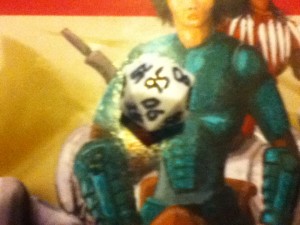 A little more than one week into the contest and there are a number of entries already. Here’s an update to keep them all in one place. If you like one, vote for it in the comments!
A little more than one week into the contest and there are a number of entries already. Here’s an update to keep them all in one place. If you like one, vote for it in the comments!
Eric Jome – 1 to 5 four times – d5!
Karl Olson – All side blank excepting the four sides with the number “20” on them and the one single side with the number “7”
Eric Jome – (That’s right, more than one entry per person is allowed, but you can only win once) 20 on one side, “re-roll” on the other nineteen.
Brian Cox – A 20 on all twenty sides?
Austin Fleming – A d20 with all the consonants on it (it has been pointed out that these already exist)
Chris Fee – Ten sides with a 20 and ten sides with a 1.
Jake P – Fudge Dice
1 | -4
2 | -3
3 | -3
4 | -2
5 | -2
6 | -1
7 | -1
8 | -1
9 | 0
10 | 0
11 | 0
12 | 0
13 | +1
14 | +1
15 | +1
16 | +2
17 | +2
18 | +3
19 | +3
20 | +4
Steffan O’Sullivan – A Fudge die!
1 face = +3
2 faces = +2
4 faces = +1
6 faces = 0
4 faces = -1
2 faces = -2
1 face = -3
(Steffan’s probabilities are a bit different than Jake’s)
Maurice Tousignant – A die with negatives could be cool -10 to +10 except you would need 21 faces for the 0. Maybe -9 to +9 and two 0s
Uriah – You could make a d20 that roughly mimics a roll of 2d6 (for settlers, monopoly, etc)
Sides would be: 3, 4, 4, 5, 5, 6, 6, 6, 7, 7, 7, 8, 8, 8, 9, 9, 10, 10, 11, 2/12
The 2/12 is the only trick part as you would then need to determine which it was (by coin flip, re-rolling etc.). You could also color one each of 4, 6, 8, 10 and the 2/12 differently to show that it was a doubles roll for games in which doubles matter.
Although he’s bowing out of this contest because he won the last one . . .
Chainsaw Aardvark – Rather than trying to cram in small symbols or esoteric two letter pairings, I would just go for groups of colors: Seven Blue, Six Orange, Four Green, Two Yellow, One Black.
Depending on the game, these could be used in a number of ways. “Any non-black or orange is a success” or “This power only activates on a green roll” or “Take damage if a secondary color (Orange/Green) shows”, and of course “Black means critical hit to reactor, ship blows up”. The above mix means you can can match any number you want to get the right probability – nine out of twenty is Blue and yellow, sixteen is any not green and so on.
Steffan O’Sullivan – Sent in this entry, again, you can only win once but can enter as many as you like. His entry was more detailed than this but this gives an idea of what he’s suggesting.
Thumb is either up or down depend on how it lands – a good yes/no or positive/negative – sideways is maybe or unclear!
Pointing finger can either point to an individual at the table or simply mean someone points something out.
Open hand can be giving, receiving, stop, or High Five!
Bomb and death’s head are obvious symbols, though there’s still a little time with the bomb – the fuse is still burning!
Flag: authority. Or Eddie Izzard.
Sun, Rain, Snow: weather impacts things.
Yin Yang: the turning of the wheel. Fortune becomes misfortune and vice versa.
Bell: an announcement.
Book: knowledge is acquired or required.
Letter: a message.
Super question mark: very mysterious!
Eye, ear: they see or hear something
Double arrows: a trade, or exchange of knowledge, or back to the beginning.
Spider: either a monster, or a gift (Grandmother Spider from Native American cultures) or a trickster (Anansi from African/Caribbean cultures)
Bag of money: it comes or it goes
Lightning bolt: something unexpected and powerful happens!
There have been some mentions of Runic dice but no specifics given.
There’s still plenty of time! What’s you’re entry? You can find the rules here.
Tortuga Setting For The Artifact
The corporate and civilian characters in the main book now have their own book. Tortuga is a setting about a Kelrath city that has it’s ruling Rantaa’ overthrown. In the power vacuum corporations from Earth slip in and start to influence the growth of the new city state. There are high hopes that this free Kelrath state will become a model for more cities to throw off oppression.
In the meantime, the civilian corporations are running amok in the relative lack of oversight on them. There are strange things going on and they’re keeping it to themselves.
The Tortuga setting includes ideas for treasure hunters including the mythic Titans.
Tortuga
The Tortuga setting includes some scripted elements but even more suggestions for a GM to develop on their own. This is a sandbox setting for the characters to deal with corruption, influence and the Kelrath up close. It also includes general suggestions for corporate characters.
Filed under News
Update On Createspace Books
My first proof book from Createspace is starting to fall apart. I’m mentioning this because I know some of my readers have an interest in book quality.
I’m a little disappointed in this. Although some of my first Lulu books had similar problems.
The other thing I’ll mention is that book saw some heavy use from my son. He is not gentle on books.
Still, this is a little too early for a book to fail. Lulu’s books last far longer but cost twice as much. That book was a bit odd anyway, maybe it’s an anomaly. I’ll keep you updated if it happens with any other books.
Filed under News
The Artifact Player’s Handbook Draft
Here it is, the third edition of the Player’s Handbook! There’s a whole new cover, some new art, new equipment, all updated for the Third Ed rules, so this book is now fully compatible with the main book. This edition includes what had been the Engineer’s Resource which includes crafting rules for equipment and vehicles, now all in one volume.
This is the rough draft. Some of the vehicle crafting rules may need tweaking and I’d like to make some additions to the standard equipment available for building. The other problem is, I found a bug in the layout software I use. If I use a layout break on a page, tables won’t wrap like they should. It’s going to take me a bit to work around that.
In the mean time, here it is!
The Artifact Player’s Handbook
Filed under News
My New Dice and A Contest!
I got my new dice in the mail a few days ago and I’ve been showing them off. I haven’t gotten to game with them yet though. Let me introduce my creation, the d20x5 and then I’ll show you the other dice I picked up. Stick around till the end to get in on a dice contest!

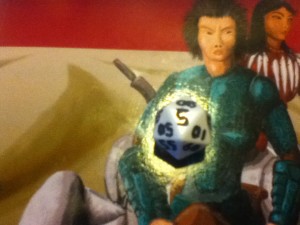
The d20x5 is my first foray into the custom dice world. A little wobbly, a little novice but all mine! Here is a die that can give me an approximately percentile experience wrapped in a d20. Just rolling this die feels comfortable to me. No diverging d10s to find as one rolls under the table, no “Which die is the tens?”, no finding one die of my favorite set and not finding the other.
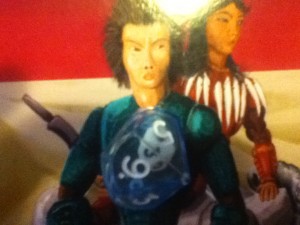
I do have to admit that this big guy is pretty cool too. It’s a nice little package for rolling a d100. Everyone that rolls it intuitively says the outer shell is the tens place and the inner is the ones. That’s pretty cool.
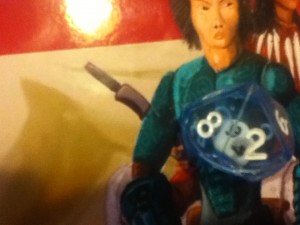
It can be a little tricky though. Sometimes the inner die doesn’t quite land flat. That’s pretty easy to fix, a light tap settles the inner dice to the side you pretty much figure it would land on. It sometimes does take some craning of the neck to see past the outer number though. The sound of the shell dice is a bit odd to my ear but I’m getting used to it. It’s the little things.
All in all though, I’ll be using this dice pretty often.
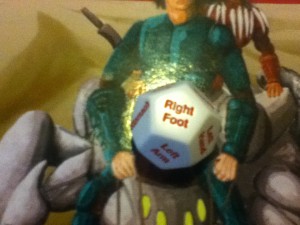
I’m not sure why I got this hit location die other than it’s cool. It’s a fast way to pull up where something lands on a person. It eliminates looking up the location on a chart. It does however give you a 4 in 12 chance of hitting a hand or a foot. So 1 in 3 hits will strike the smallest segments of the body. We were talking about it and figured that it could make sense in hand to hand situations.
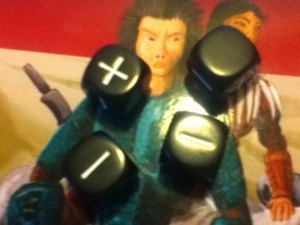
I also picked up some FUDGE dice. We have a new project that we’re going to use the FUDGE system for. I thought about using FATE but it has a lot of baggage like FATE points and compels that I don’t really need. Yeah, I know, with FATE Core and FATE Accelerated all the rage now it would be a popular choice but FUDGE is just more straightforward for what I want.
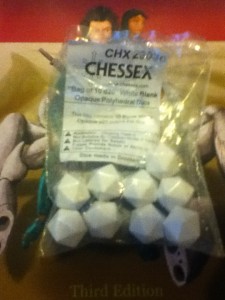
Now, the contest. Here’s where you come in. Come up with something cool to put on a d20. The sides of these puppies are small so I can only fit one to two characters on them. That means that if your die needs a cheat sheet to be used that’s okay. For instance Y could be a “yes” while Yb is “yes but”.
Come up with something cool, something that will fit on one of these puppies and I’ll do my best to make that die. I’m not using a laser to etch the die, don’t expect perfection but I should be able to produce usable and legible.
Write up your submission in the comments below or if you’re super secret, you can email your super secret submission to submissions@theartifact.net
You’ll be judged based on the following criteria.
Does it fit on a d20? That’s an important one.
How universal is this concept? Could everyone enjoy this die?
How revolutionary is this concept? Does it blow us away?
Does it solve a practical need?
Winner get’s me hacking at a poor white die twenty to make that will get mailed to your (the winner’s) address and a copy of The Artifact third edition.
2nd place gets me making their die with the same novice skill and mailing it to your (the 2nd place winner’s) address.
Contest ends September 30th. Judging ends and winners announced Friday October 4.
Do you have what it takes? What does it take? I guess we’ll find out October 4th!
Filed under Experimental Mechanics, Fan Submissions, News
Progress With The 3e Player Handbook
I had gotten to the point in rewriting the Engineer’s Resource where I had to confront the biggest and hairiest challenge, building vehicles. I was a bit intimidated by this, especially when it came to building vehicle drive systems. I’m happy to say I’ve cracked that bit. The system is more consistent and hopefully more intuitive.
There’s still a bunch to do, I’ve been making notes as I go about things I’d like to see work better so I’ll be going back and addressing these next.
I’ve tried various tests so far against real world vehicles and ones in the book and they’ve stood up to the tests so far but I’ll be handing the book over to Cody soon to see if he can’t abuse the system.
I was hoping to have some time to work on a cover but that hasn’t happened yet. I have a few thoughts after going to a Star Wars exhibit in the Indiana State Museum. It’s not that I want to copy Star Wars but there was a lot of material in the exhibit that talked about how the model makers and the sound designers thought about producing the look of the movies that I found informative.
Primarily the idea that was repeatedly discussed is that the audience expects certain visual and audio queues. If you don’t give it to them then they get confused. Now, I’ve known that for a while but the examples given gave me a few new ways to think about it.
What do players expect? Sometimes game designers want the players to get excited about nuance and possibility (ok, I do anyway) but the players want a hard hitting game that’s straightforward. They want to know they can have that kind of game and have the game reassure them that it’s okay to want it. I’m okay with that too, so that’s what I’m going to try for.
Filed under News
Rules Rules Rules
Games have rules or at the very least a rule. RPGs tend toward having a lot of rules. Even rules lite games usually have as many pages of rules as a board game of standard complexity. Why is that? Is there any way around it? If you do get around it, what are the consequences?
First, a quick and dirty history of RPGs. Early RPGs were fairly light compared to what came in the 90’s. Then there was a move toward heavy books full of rules. In the next decade narrative driven games emerged that tend to have a smaller page count. Next came the Old School Revolution that focused its efforts on early RPGs that ran lite.
There’s a constant struggle to both expand what an RPG can govern and a wish to cut the discreet number of rules in the game. If the market of RPG customers have more free time, better visual acuity and the focus to support a large set of rules in their head, (usually late teen players) the size of RPGs get bigger. This has the effect of making it more difficult for young players (pre or early teens) to grasp the game and slows the rate that new players take up the hobby. It also is harder for working parents and older players who may have a hard time reading small type to adopt these large tomes.
Many games reduce their rule sets by having a central mechanic that is intended to govern (nearly) all interactions. This has gone a long way to make games easier to comprehend but the discrete rules that can spin off the core rules are also effectively endless so a game designer can still easily fill hundreds of pages with special case rules.
A game can reduce its rule set by applying what’s called “rule 0” or “the GM’s word is final”. Old School Revolution games rely in this heavily. The GM decides how rolls apply and often spot rule when a question arises. They make up a rule on the spot of how to resolve the situation. This can change from instance to instance but many gaming groups develop their own set of house rules, that if ever written down would bloat their lite game into something more comparable to a new school game from the 90’s.
A third way to reduce the set of rules is to not model a world but to give rules to govern the story being told. These “Narrative” games have a double edged sword to deal with in that they give lots of power to the players. This power if not carefully managed can lead to the game breaking down into something that is no longer a game because the rules do not sufficiently control play.
Large Rule Sets, Good For Players?
Early on in my gaming, I was a rules lawyer and I caused plenty of trouble as one. I wasn’t malicious, but I did cause arguments and I did use the rules to break the game when it served me. Back then, I probably couldn’t tell you why I rules lawyered. Now I understand things a bit better.
Rules that don’t change give power to the players. They allow the players to know how the game is played and helps them to tell the kind of story they want with their characters. Because of this, I’ve always viewed the written rules as my friend and any unwritten and malleable rule handed down from the GM as something I couldn’t rely on.
Think about a game of football where a player scores but the Referee can change the score based on how he felt about the effort? Would you know how to produce a strategy that would win the game? Possibly if that Ref was consistent you could. But what if he wasn’t consistent? What if he was mostly consistent but occasionally he would change his mind at the last moment? These are things I have seen GMs do.
Rules Help The GM
Another reason comprehensive rule sets can be good is that the GM has a heavy load to lift running a game. When there isn’t a rule to cover something, I’ve seen GMs default to “you can’t do that” even though most games tell the GM to make something up. When trying to handle all the other responsibilities of a game though, it can be hard for a GM to suddenly come up with how a novel solution should work. What’s worse is when the players want to replicate the effect of a novel solution and it threatens to unbalance the game.
Rules can also help build trust in a GM if they apply the rules evenly and the players see them doing so.
Pros vs Cons
On the one hand, a comprehensive rule set can help a game but on the other, it’s a barrier to new players, especially the young and the time strapped. There was a lot of wisdom in the “Basic” and “Advanced” rule sets of yesteryear. Get started with the basic and move onto the Advanced when you’re ready. Sometimes Quickstarts are a good approximation of the old Basic rule sets but they rarely are as flexible, usually only providing the GM an understanding of how to play a single adventure.
Player’s Handbook / Engineer’s Resource
 The material for the old player’s handbook is updated for a while now. Although I still haven’t really come up with a cover. I have this concept that I want a group of PCs carrying big bulging backpacks full of loot. I also have the desire to have them trudging through thick mud. But that’s not interesting enough.
The material for the old player’s handbook is updated for a while now. Although I still haven’t really come up with a cover. I have this concept that I want a group of PCs carrying big bulging backpacks full of loot. I also have the desire to have them trudging through thick mud. But that’s not interesting enough.
Then the idea of having three PCs riding on Pettok or Drammatok, maybe again laden down with treasures, and an underground vista behind them sounds good to me too. Still, two books with riders on the front? I don’t know.
I’ve churned away at converting the Engineer’s Resource to the third edition rules. The process has gone well so far and I’m nearly to the biggest and hairiest part, building vehicles. I was hoping that the new system would shorten the book as far as pages go but so far it’s winding up about even.
I’m also thinking, with all the news going on about the LS3 and the Atlas robots, that there should be more robots to go around in the Player’s Handbook. Maybe it would be a good thing to give to Comm Officers?
Filed under News
It’s Free RPG Day!
 For free RPG day Store32 is offering our entire PDF line up of games for free! Come and get The Artifact RPG and Steampunkfitters RPG PDFs at no charge! If you want to test the waters there’s also The Warp quickstart for The Artifact with only the rules you need for the included adventure.
For free RPG day Store32 is offering our entire PDF line up of games for free! Come and get The Artifact RPG and Steampunkfitters RPG PDFs at no charge! If you want to test the waters there’s also The Warp quickstart for The Artifact with only the rules you need for the included adventure.
How can we offer these fabulous titles for free? You could almost say that every day feels like free RPG day for us.
(Shhh! Don’t tell them that we normally offer them for free.)
Also check out 1KM1KT for more free games than you or your grandpa can shake a stick at.
Filed under News

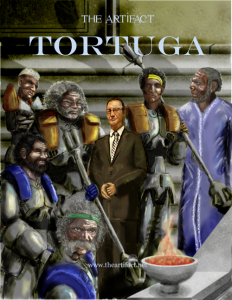
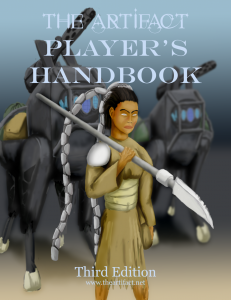

 The Free RPG Blog
The Free RPG Blog